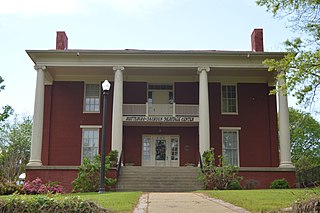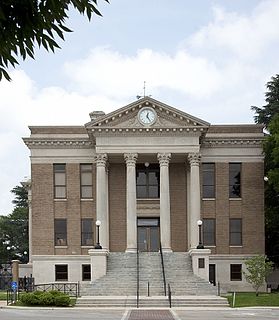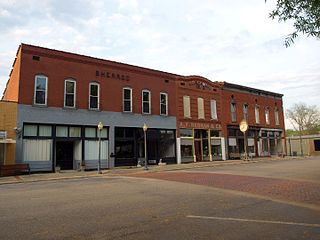
Snead State Community College is a public community college in Boaz, Alabama. It began as a private seminary in 1898 and became part of the Alabama Community College System in 1967. Snead awards associate degrees in 79 programs and certificates in 24 programs.

The Grove Hill Courthouse Square Historic District is a historic district in Grove Hill, Alabama. It is centered on the Clarke County Courthouse and the boundaries are roughly Cobb, Court, Jackson, and Main Streets. It features examples of Greek Revival and Queen Anne architecture. The district was added to the Alabama Register of Landmarks and Heritage on March 24, 1995 and to the National Register of Historic Places on April 30, 1998.

Cherokee Plantation is a historic house in Fort Payne, Alabama. The house was built in 1790 as a two-story log cabin by Andrew Ross, a judge on the Cherokee Supreme Court and brother of Principal Chief John Ross. In 1834 a second log cabin was built connected to the rear of the original cabin, and a third was built to the northeast, separated by a breezeway. Ross, being one-eighth Cherokee, was forced to leave his home in 1838 under the provisions of the Treaty of New Echota, of which Ross was a signatory; a portion of the Cherokee Trail of Tears passes in front of the house.

Flint River Place is a historic residence near Huntsville, Alabama. The house was built between 1844 and 1850 by Daniel Friend, a planter who came to Alabama from Kentucky around 1826. The house is Greek Revival in style, with Federal and Georgian Revival elements. It began as an L-shaped house, with an additional ell and one-story shed roofed infill built in 1930. The house is clad in poplar siding and the gable roof was originally slate over wooden shingles, but has been replaced by asphalt shingles. Two gable-end chimneys have simple, Federal-style mantels. The façade is three bays, with a one-story portico supported by four columns, with a balcony above; it replaced a gable-roofed, two-column portico in 1978. The main entrance is flanked by sidelights and topped with a fanlight. Windows on the entire house, except for the southeast bedroom addition, are six-over-nine sashes. The house was listed on the Alabama Register of Landmarks and Heritage in 1981 and National Register of Historic Places in 1982. The house was heavily damaged in a fire in 2012.

The Gurley Historic District is a historic district in Gurley, Alabama. The town was originally the plantation of John Gurley, who came to Madison County from North Carolina in the 1830s. In 1857, the Memphis and Charleston Railroad built its line through the property, and Gurley constructed a water tank to service the line's locomotives. A post office was established in 1866, at which time only a few families lived in the area. The town incorporated in 1890, and the population immediately began to grow. Industry was attracted to the area by its abundance of lumber; many sawmills, producers of wooden barrels, and the Eagle Pencil Company set up shop near the town. Retail establishments were centered on Joplin Street, however a fire in 1923 destroyed most of the structures. Depletion of the area's timber and the greater influence of neighboring Huntsville drew industry away in the 1920s and 1930s, though despite declining population a new Madison County High School was built in 1936.

The Leech–Hauer House was a historic residence in Huntsville, Alabama. It was built circa 1830 by professional carpenter William Leech. It was built in a transitional style between Federal and Greek Revival. The house was a two-story, L-shaped structure, with a front porch which was later enclosed. John G. Hauer purchased the house in 1904, and it remained a family residence until it was sold to a flower shop in 1974. It was purchased by physician Parker Griffith and his brother in 1977. The house was listed on the Alabama Register of Landmarks and Heritage and National Register of Historic Places in 1978. The house was subsequently demolished, and a modern medical office building was constructed on the site in 1988.

Winston Place is a historic residence in Valley Head, Alabama. William O. Winston, a lawyer from Rogersville, Tennessee, moved to DeKalb County in 1838. Winston would later serve in the Alabama House of Representatives and was a major investor in the Wills Valley Railroad, which would later connect Chattanooga with Birmingham. Soon after arriving in Alabama, Winston built a two-story I-house. In the late 19th century, the exterior was extensively modified with a two-story, wrap-around, Colonial Revival porch and tetrastyle portico. Around 1930, rear outbuildings were connected to the house, giving it an L-shaped plan. The house was listed on the Alabama Register of Landmarks and Heritage in 1976 and the National Register of Historic Places in 1987.

The Attalla Downtown Historic District is a historic district in Attalla, Alabama. The city was founded in 1870 along the Alabama and Chattanooga Railroad. It quickly developed into a major iron ore export hub. After fires in 1887 and 1891, most of the frame buildings downtown were replaced with brick structures. The oldest buildings in the district, which date from the 1880s and 1890s, are built in Folk Victorian styles, with corbelled cornices and other decorative elements. Later buildings are in more plain Commercial Brick styles, while others were built in more academic styles, including the Art Moderne Etowah Theatre and the Colonial Revival Post Office building. The district was listed on the Alabama Register of Landmarks and Heritage in 2011 and the National Register of Historic Places in 2013.

The Colonel O. R. Hood House is a historic residence in Gadsden, Alabama. The house was built in 1904 by Oliver Roland Hood, an attorney, politician, industrialist, and one of the founders of the Alabama Power Company. He was also a delegate to the state's 1901 constitutional convention. It was designed and constructed by architect/builder James Crisman. Upon Hood's death in 1951, the house was purchased by the Woman's Club of Gadsden, a community service organization. The house is built in Classical Revival style with some Victorian details. The façade is dominated by a double-height portico supported by four Ionic columns. The front door is flanked by wide sidelights and a tall transom. The house also has two side entrances on octagonal bays at the rear of each side. The house was listed on the Alabama Register of Landmarks and Heritage in 1985 and the National Register of Historic Places in 1986.

The Brown–Proctor House is a historic residence in Scottsboro, Alabama. The house was built in 1881 by John A. Brown, who sold it just one year later. He sold the house to General Coffey, who bought the house for his daughter Sarah, for 3,200 dollars. John Franklin Proctor, a politician who served in the Alabama Legislature from 1892 through 1899 and was an attorney for the Scottsboro Boys in 1931, purchased the house in 1907. Proctor made numerous renovations to the house, including altering the two-story front portico with Tuscan columns into its current state of a single-level porch supported by Ionic columns with a central second floor balcony. A three-room addition was also built onto the back of the house, adding to the central hall plan of the original house. After his death in 1934, Proctor's family owned the house until 1981.

The Public Square Historic District is a historic district in Scottsboro, Alabama. Although Scottsboro had been the county seat of Jackson County since 1870, the town's earliest commercial development was centered on the Memphis and Charleston Railroad line, one block north of the square. After an 1881 fire along the rail line, some businesses began to rebuild around the square. Once the Tennessee Valley Authority brought prosperity to the region in the 1930s, development around the courthouse began to accelerate. The current Jackson County Courthouse was built in 1912 with matching Classical Revival porticos on two sides. Commercial buildings around the square are one or two stories and all of brick. While most are built in simple, lightly decorated commercial styles, some late 19th-century buildings have Victorian detailing. The district was listed on the Alabama Register of Landmarks and Heritage in 1981 and the National Register of Historic Places in 1982.

The Dancy–Polk House is a historic residence in Decatur, Alabama. The house was built in 1829 for Colonel William Francis Dancy, an early settler in the area, who later moved to Franklin, LA. It is the oldest building in Decatur, and one of only four to survive the Civil War. Dancy came to North Alabama from southern Virginia, and built a Georgian house popular in his homeland. The two-story frame house has a double-height portico with four Doric columns on each level. The house was listed on the Alabama Register of Landmarks and Heritage in 1978 and the National Register of Historic Places in 1980.

The Forest Home is a historic residence near Trinity, Alabama. The house was built in 1856 on land given to him upon his father-in-law's death. Davis was a farmer, a teacher at LaGrange College, and a leader of the Grange movement of farmer advocacy. The house remained in the Davis family as a working cotton farm until 1973. The house is a two-story I-house with a single-story rear ell. A two-story porch adorns the front façade. The house was listed on the Alabama Register of Landmarks and Heritage in 1979 and the National Register of Historic Places in 1980.

The Athens Courthouse Square Commercial Historic District is a historic district in Athens, Alabama. Athens was founded in 1818 when Robert Beaty and John D. Carroll began selling tracts of land. The following year, the town was chosen as the county seat of the newly formed Limestone County. Commercial development around the courthouse square was swift, aided by the strong cotton market. The town and courthouse suffered heavy damage during the Civil War in the Battle of Sulphur Creek Trestle. Athens' revival was slowed by major fires in 1882, 1894, and 1897, as well as the Panic of 1893. Redevelopment was spurred again in the 1910s and 1920s by a diversified economy with increased manufacturing, and in the 1930s by electricity provided by the Tennessee Valley Authority. Notable buildings in the district are the Limestone County Courthouse, built in 1919 in Neoclassical style with Palladian influences. The Old Post Office building was completed in 1933. The district was listed on the National Register of Historic Places in 1997 and the Alabama Register of Landmarks and Heritage in 2012.

The Blackburn House is a historic residence near Athens, Alabama. The house was built around 1873. It is a one-and-a-half-story Saltbox-style house with an Italianate portico. The portico has four chamfered edge columns supporting a hipped roof. The portico is flanked by two-over-two sash windows on each floor; the same windows are used on the sides on the first floor and for the front rooms on the second floor. Small casement windows are found above the portico and in the attic areas on the rear sides of the house. The house has a center-hall plan with four rooms on the ground floor and two on the upper floor. Since restoration in the early 1980s, the house has served as an antique store. The house was listed on the Alabama Register of Landmarks and Heritage in 1983 and the National Register of Historic Places in 1984.

The Courtland Historic District is a historic district in Courtland, Alabama. Courtland was founded in 1818 and incorporated the following year. Its location was chosen to be close to the Tennessee River to facilitate transportation, but also close to cotton plantations to the south. The town's founders envisioned becoming the county seat of the newly formed Lawrence County, but the title instead went to Moulton. Many of the earliest structures in Courtland were built of logs, and were later replaced with frame and brick buildings. Development plateaued by 1830, but received a slight bump from the Tuscumbia, Courtland and Decatur Railroad beginning in 1834. The oldest houses in the district date from this era, including the 1828 Federal-style John McMahon House and several I-houses.

The College Place Historic District is a historic district in Florence, Alabama. The area was the site of a Confederate fortification during the Civil War. In 1882 the land was purchased by Judge J. J. Mitchell and used as pasture land; Mitchell's house sits on Wood Avenue to the east of the district. The property began to be sold off in the 1900s, with the oldest house in the district dating to 1907. Construction in the district accelerated in the mid- to late-1920s, with many professionals including physicians, merchants, scientists, and attorneys building homes in the neighborhood. Styles represented include Mission Revival, Georgian Revival, and bungalows. The district rises on a slight slope above the campus of the University of North Alabama, and has vistas of the campus including Wesleyan Hall. The district was listed on the Alabama Register of Landmarks and Heritage in 1992 and the National Register of Historic Places in 1995; the boundaries were extended in 1998.

The Wood Avenue Historic District is a historic district in Florence, Alabama. The residential neighborhood was primarily developed after Reconstruction, although five houses date from before the Civil War. By the time of Florence's economic boom of the 1880s, the most fashionable upper-class neighborhood in Florence, today known as the Sannoner Historic District, had already been filled in, leading development to move to Wood Avenue to the west. Most homes built during this time were large, Victorian structures, including many elaborate examples of Queen Anne architecture.

The Chambers–Robinson House is a historic house located at 910 Montgomery Avenue in Sheffield, Alabama.

The John Daniel Rather House is a historic residence in Tuscumbia, Alabama. The house was built in 1823 by William H. and Catherine Winter, who came to The Shoals from Prince William County, Virginia. It was taken over by the Union Army during the Civil War and used as the headquarters of General Florence M. Cornyn. After the war, the house was purchased by John Taylor Rather, an early North Alabama settler who was deputy sheriff of Madison County, and a longtime member of the Alabama House of Representatives and later the Alabama Senate. His son, John Daniel Rather, also served in both houses of the state legislature, and was President of the Memphis and Charleston Railroad.






















